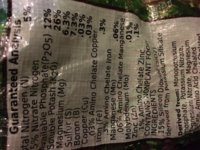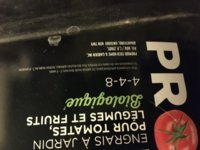ChinaVoodoo
Moderator
There are a lot of different fertilizer recommendations out there, and they are often dependent on regional soil composition and soil test results. The purpose of this thread is to explain how you take these recommendations and figure them into how much to actually apply.
I will be taking recommendations from Virginia Tech's 2019 report for flue cured tobacco. FYI, the nitrogen rates recommended for burley are significantly higher.
Their recommendations are as follows:
Nitrogen 50-80lbs/acre depending on soil depth
Phosphorous 40-230lbs/acre depending on soil test
Potassium 100-175lbs/acre depending on soil test
We will go with 80, 80, & 175 (respectively) for all of these example calculations.
This is represented as 80-80-175 lbs/acre
"but my garden is not that big!"
Yes. So let's switch to a combination of metric and imperial. This is how it makes sense to me: 1lb/acre = 1.04grams per 100 square feet. (1lb/1acre x 454g/1lb x 1acre/43560square feet x 100)
This means that our recommendation for lbs per acre is basically the same as our recommendation for grams per 100square feet. So for every 100square feet of garden, you need 80g N, 80g P, & 175g K.
Calculations:
Let's say you have a pure N fertilizer, something like 60-0-0.
Only 60% of the weight of the fertilizer is N. Therefore if you need 80g of N, it makes sense that you would need more than 80g of the fertilizer.
The calculation is 80/0.60 = 133g.
So 133g of the 60-0-0 will give you 80g N and you will apply that amount to every 100square feet of your garden.
Let's say you have a fertilizer which is not purely one chemical.
Let's say it's 20-20-40.
So let's calculate how much fertilizer is required to get the amount of N we need.
80/0.20 = 400g per 100square feet
But, how much potassium have we acquired? Let's calculate backwards using the amount of fertilizer you added to get the right amount of nitrogen. Weight of fertilizer x %K
400g x 0.4 = 160g.
So we have added 160g of potassium, but we were aiming for 175. You might want to save the hassle and leave it at that because it's well within the recommendations. However, if you wanted to add more K, you could do so by finding a fertilizer that only has K in it. You would only have to calculate to add 15g K per 100 square feet more.
What about "fertilizers" that have very low numbers? It's the same. Just remember to always move the decimal place over two positions to change it from a percentage to a ratio.
Lets say you have found bags of 0.5-0.5-0.5.
To calculate N,
80 ÷ 0.005 = 16,000g
(this equals 35lbs)
Then you do the calculation to double check potassium. It results in that you still need another 95g per 100 square feet. You will need to find something else to add.
A note on organic fertilizers.
Nitrogen in many organic fertilizers is different and often takes many years so break down. For some, like bloodmeal, they break down faster. For green products like alfalfa and vetch, for every gram of nitrogen in it, the plants can only use 25% of it in the first year. If you use the same product every year, this goes up to 33%.
These percentages for P and K are 60% and 90%, respectively.
So if you are using something like alfalfa pellets which might be something like 2.5-1-3, you should start your calculations by multiplying it by the applicable utilization percentages. That means this fertilizer is effectively 0.625-0.6-2.7. Continue from there.
I will be taking recommendations from Virginia Tech's 2019 report for flue cured tobacco. FYI, the nitrogen rates recommended for burley are significantly higher.
Their recommendations are as follows:
Nitrogen 50-80lbs/acre depending on soil depth
Phosphorous 40-230lbs/acre depending on soil test
Potassium 100-175lbs/acre depending on soil test
We will go with 80, 80, & 175 (respectively) for all of these example calculations.
This is represented as 80-80-175 lbs/acre
"but my garden is not that big!"
Yes. So let's switch to a combination of metric and imperial. This is how it makes sense to me: 1lb/acre = 1.04grams per 100 square feet. (1lb/1acre x 454g/1lb x 1acre/43560square feet x 100)
This means that our recommendation for lbs per acre is basically the same as our recommendation for grams per 100square feet. So for every 100square feet of garden, you need 80g N, 80g P, & 175g K.
Calculations:
Let's say you have a pure N fertilizer, something like 60-0-0.
Only 60% of the weight of the fertilizer is N. Therefore if you need 80g of N, it makes sense that you would need more than 80g of the fertilizer.
The calculation is 80/0.60 = 133g.
So 133g of the 60-0-0 will give you 80g N and you will apply that amount to every 100square feet of your garden.
Let's say you have a fertilizer which is not purely one chemical.
Let's say it's 20-20-40.
So let's calculate how much fertilizer is required to get the amount of N we need.
80/0.20 = 400g per 100square feet
But, how much potassium have we acquired? Let's calculate backwards using the amount of fertilizer you added to get the right amount of nitrogen. Weight of fertilizer x %K
400g x 0.4 = 160g.
So we have added 160g of potassium, but we were aiming for 175. You might want to save the hassle and leave it at that because it's well within the recommendations. However, if you wanted to add more K, you could do so by finding a fertilizer that only has K in it. You would only have to calculate to add 15g K per 100 square feet more.
What about "fertilizers" that have very low numbers? It's the same. Just remember to always move the decimal place over two positions to change it from a percentage to a ratio.
Lets say you have found bags of 0.5-0.5-0.5.
To calculate N,
80 ÷ 0.005 = 16,000g
(this equals 35lbs)
Then you do the calculation to double check potassium. It results in that you still need another 95g per 100 square feet. You will need to find something else to add.
A note on organic fertilizers.
Nitrogen in many organic fertilizers is different and often takes many years so break down. For some, like bloodmeal, they break down faster. For green products like alfalfa and vetch, for every gram of nitrogen in it, the plants can only use 25% of it in the first year. If you use the same product every year, this goes up to 33%.
These percentages for P and K are 60% and 90%, respectively.
So if you are using something like alfalfa pellets which might be something like 2.5-1-3, you should start your calculations by multiplying it by the applicable utilization percentages. That means this fertilizer is effectively 0.625-0.6-2.7. Continue from there.
Last edited:






